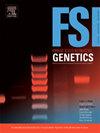Current progress and future perspectives in personal identification of monozygotic twins in forensic medicine
IF 3.1
2区 医学
Q2 GENETICS & HEREDITY
引用次数: 0
Abstract
The personal identification of monozygotic (MZ) twins is of great importance in forensic medicine. Due to the extreme similarity in genetic between MZ twins, it is challenging to differentiate them using autosomal STR genotyping. Forensic experts are striving to explore available genetic markers that can differentiate between MZ twins. With the advent of next-generation sequence (NGS), an increasing number of genetic markers have been demonstrated to effectively differentiate between MZ twins. Here, we summarized for the relevant studies on MZ twins’ differentiation and discussed the limitations of the underlying markers. In details, single-nucleotide variants (SNVs), copy number variation (CNV), mitochondrial DNA (mtDNA), DNA methylation, and non-coding RNA have been demonstrated considerable value. Furthermore, the utilization of proteomics, metabolomics, and microbiomics has shed light on MZ twin differentiation. Additionally, we introduce the methodologies for MZ differentiation based on external morphological variations observed in the human body. Looking to the future, the process of aging may represent a novel avenue for the differentiation of MZ twins.
法医学中同卵双胞胎个人鉴定的现状与展望。
同卵双胞胎的身份鉴定在法医学中具有重要意义。由于MZ双胞胎在遗传上的极端相似性,使用常染色体STR基因分型来区分它们是具有挑战性的。法医专家正在努力探索可以区分MZ双胞胎的遗传标记。随着下一代序列(NGS)的出现,越来越多的遗传标记被证明可以有效地区分MZ双胞胎。本文对MZ双胞胎分化的相关研究进行了综述,并讨论了相关标记的局限性。具体而言,单核苷酸变异(snv)、拷贝数变异(CNV)、线粒体DNA (mtDNA)、DNA甲基化和非编码RNA已被证明具有相当大的价值。此外,蛋白质组学、代谢组学和微生物组学的应用为MZ双生子分化提供了线索。此外,我们还介绍了基于观察到的人体外部形态变化的MZ鉴别方法。展望未来,衰老过程可能是MZ双胞胎分化的新途径。
本文章由计算机程序翻译,如有差异,请以英文原文为准。
求助全文
约1分钟内获得全文
求助全文
来源期刊
CiteScore
7.50
自引率
32.30%
发文量
132
审稿时长
11.3 weeks
期刊介绍:
Forensic Science International: Genetics is the premier journal in the field of Forensic Genetics. This branch of Forensic Science can be defined as the application of genetics to human and non-human material (in the sense of a science with the purpose of studying inherited characteristics for the analysis of inter- and intra-specific variations in populations) for the resolution of legal conflicts.
The scope of the journal includes:
Forensic applications of human polymorphism.
Testing of paternity and other family relationships, immigration cases, typing of biological stains and tissues from criminal casework, identification of human remains by DNA testing methodologies.
Description of human polymorphisms of forensic interest, with special interest in DNA polymorphisms.
Autosomal DNA polymorphisms, mini- and microsatellites (or short tandem repeats, STRs), single nucleotide polymorphisms (SNPs), X and Y chromosome polymorphisms, mtDNA polymorphisms, and any other type of DNA variation with potential forensic applications.
Non-human DNA polymorphisms for crime scene investigation.
Population genetics of human polymorphisms of forensic interest.
Population data, especially from DNA polymorphisms of interest for the solution of forensic problems.
DNA typing methodologies and strategies.
Biostatistical methods in forensic genetics.
Evaluation of DNA evidence in forensic problems (such as paternity or immigration cases, criminal casework, identification), classical and new statistical approaches.
Standards in forensic genetics.
Recommendations of regulatory bodies concerning methods, markers, interpretation or strategies or proposals for procedural or technical standards.
Quality control.
Quality control and quality assurance strategies, proficiency testing for DNA typing methodologies.
Criminal DNA databases.
Technical, legal and statistical issues.
General ethical and legal issues related to forensic genetics.

 求助内容:
求助内容: 应助结果提醒方式:
应助结果提醒方式:


